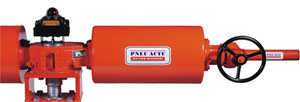
AP SERIES ACTUATORS
Location:Home >> AP SERIES ACTUATORS
|
AP Series Actuator for Quarter-turn |
 |
Simple Actuator Mounting
Piston Protection
High Efficiency
Corrosion Resistance
Internal Tie Rods
Wide Adjustable Stopper
Replaceable
Wear Resistance
Safe Spring Module
Simple Assembly
To ensure long life and efficiency the actuators contain replaceable bearings and a high performance internal coating to resist wear and corrosion. Due to the wide torque range of the AP-Series and the flexibility of its modular construction the actuation of large valves is simple and actuator selection is optimized. Manufacture and assembly of the AP-Series actuator is strictly controlled by our QA systems allowing us to offer a reliable, high quality actuator produced to our own unique design

Controls and Accessories
Limit switches: For remote position indication & sequencing.
• Electric or pneumatic
• SP-DT or DP-DT
• Low power
Pressure Switches: A device which transmits an electrical signal at a preset pressure.
Positioners: Utilize plant air as the power source to precisely position an actuator relative to a control signal (such as 3 to 15 psig instrument air) from a remote device.
Transducers: Convert an electrical control to a pneumatic control signal (e.g., 4 to 20 ma 3 to 15 psig).
Filters and lubricators: Filters are recommended when the condition of plant or instrument air could affect the performance of control devices. Lubricators are recommended in all systems not operated by positioners.
Solenoid valves: For remote electrical actuation:
• General purpose or explosion proof
• Voltage (AC or DC)
• 2-way
• 3-way (1 for spring return actuator)
• 4-way (1 for double acting actuator)
• Maximum pressure and temperature
Pneumatic pilot valves: For remote pneumatic actuation.
Check valves and shuttle valves: To allow flow in only one direction or to divert flow to another direction.
Quick exhaust valves: To permit fast opening and/or closing by exhausting the cylinder directly to atmosphere.
Speed control valves: To throttle the air flow to and from the actuator to meet the operational characteristics of the system.
Regulators and relief valves: To regulate the supply pressure to the actuator